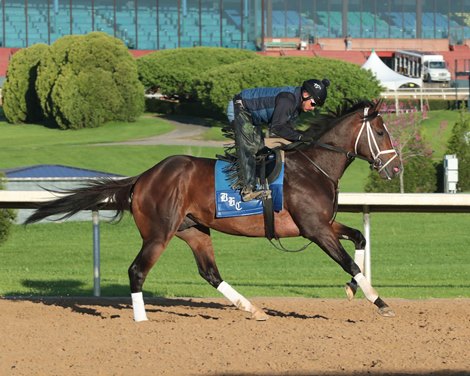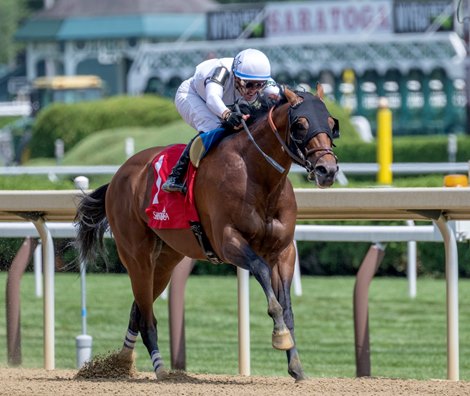
Canterbury Park in Shakopee, Minn.
Canterbury Park will become the first track in the modern history of North American racing to time Thoroughbred races from the break of the gate, eliminating “run-up” distances. The track announced the change in a press release Monday.
“Accuracy matters. This is a watershed moment for American racing,” said Thoroughbred Idea Foundation executive director Patrick Cummings. “For more than a century, we have endured inaccuracy in racing’s most fundamental data points – time and distance. The inconsistencies created by running and timing races with run-up are too numerous to count, but this Is a much-needed first step towards embracing accuracy – for horseplayers, horse owners and any stakeholder in the sport.”
“Canterbury Park’s management team is to be commended for being the first to take the lead on this and I am quite confident they will not be the last!”
RUN-UP, RUN OUT
The term “run-up” has been used to account for the untimed portion of Thoroughbred races which is the distance between where the starting gate is placed and the spot on the track which is the published race distance from the finish.
“In some dirt races in America – for example, one mile on dirt at Santa Anita or Del Mar, or six furlongs on dirt at Churchill Downs,” Cummings said, “horses run for 200 feet or more before they get to the point which is the published distance of the race. It is from that point when timing starts. In some turf races, it’s even longer.”
“It is remarkable to think about the millions of races which have not only been timed in this inconsistent and inaccurate fashion, but consider the reality that nearly every race distance in a condition book or program is also wrong. There is no track on this continent that has been unaffected by this, but change starts with the first mover and that’s Canterbury.”
In the Canterbury press release, the track’s senior director of racing Chris Merz noted: “By timing races from the moment the gate opens, we are being more transparent with thoroughbred timing and providing our bettors with the accurate information they have been wanting for years.”
Horseplayer, racing analyst and figure maker Randy Moss was also cited in the Canterbury release.
“This will produce more consistency in timing,” Moss said.
“What handicappers will notice is that opening fractional times will be decidedly slower. A first fraction that would have been 21 and 4 [seconds] might be 22 and 4 or 23.”
HUMAN RACE TIMING EQUIVALENT “UNTHINKABLE”
For those unaware of the state of inaccuracy in North American race timing, the equivalent to human track races could make it clear, Cummings said.
“Imagine if in human, 100-meter sprints, depending on the stadium where the event was taking place, sprinters might run 102 or 104 or 106 meters from the start to the finish, but the timer didn’t start until the first runner crossed the point which is 100 meters from the finish. Such inaccuracy and inconsistency is unthinkable at the track and field’s top level, yet it’s been the norm all over the continent and remains the case for many today.”
Cummings wrote an extensive piece on the perpetual mis-timing of North American races in October 2014 for Thoroughbred Racing Commentary. That piece can be reviewed by clicking here.
“We have accepted gross inaccuracy for more than a century of U.S. race timing where a race published as six furlongs might actually be about 6 1/3 furlongs from start to finish, we’ve just timed the last six furlongs and given horses the chance to get to full speed before starting the clock. It’s wholly unacceptable it has gone on for this long but it’s great to know change is coming at one track.
TRICKY TRANSITION
The transition to gate-to-finish timing could occasionally come with some difficulties.
If the starting gate is not able to be placed exactly at the point which is the published race distance from the finish, race distances should be reported to the public as longer than they were originally published.
“I anticipate some bumps along the way with any transition. If the starting gate needs to be placed one mile and 50 feet from the finish, then the race should be reported as one mile and 50 feet, or perhaps even reported in uniform, metric distances to align with many other global racing jurisdictions and human races too,” added Cummings.
Cummings has highlighted instances where graded stakes races are run over distances far longer than the published distance.
“For each of the last few years, Saratoga has run the Grade 2 Bowling Green over a distance they report as 1 3/8 miles on the inner turf course, sometimes calling it ‘about’ 1 3/8 miles. A review of the timing shows it clearly is much longer than that, with horses running more than a half-furlong longer than what was published.”
Cummings tweeted about these incidents at the time (see below).
R6 at Saratoga today your annual reminder (in advance of Sunday’s G2 Bowling Green) that races at Saratoga over 1 3/8m on inner turf, with rail at 18ft, are over a distance closer to 1 1/2m than 1 3/8m.
— Pat Cummings (@PatCummingsTIF) July 28, 2023
“This is a very meaningful first step in the process. I’m hopeful more will follow Canterbury’s lead and embrace accuracy, a real sign of respect for racing’s customers, particularly horseplayers.”
Canterbury’s season is due to begin in May 2024. Race timing is provided by Equibase via the Gmax timing system.









Leave feedback about this